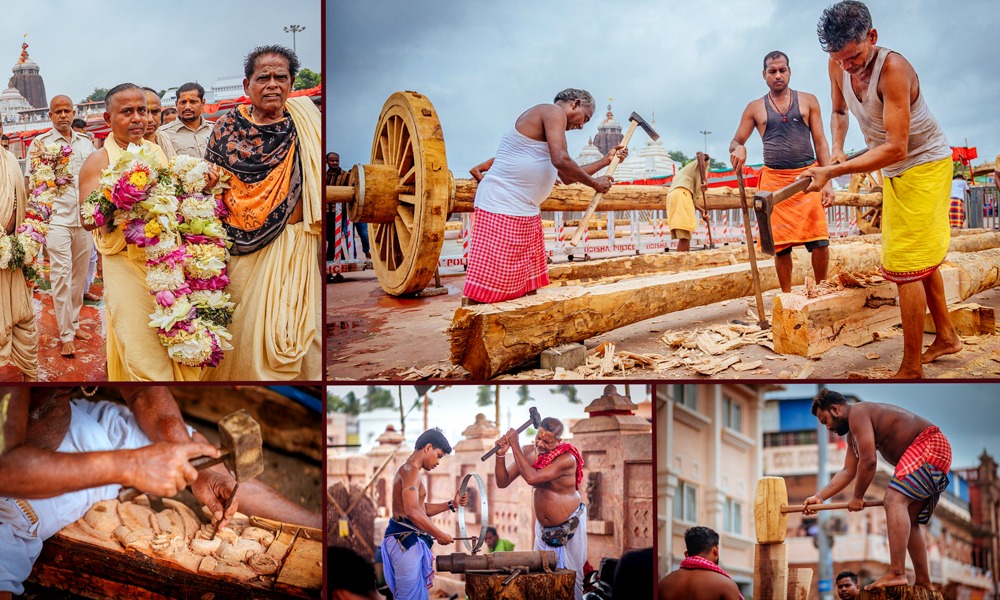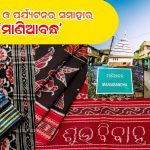Rath Yatra, also known as the Festival of Chariots, is a breathtaking spectacle that embodies the heart and soul of Odisha. Celebrated with unmatched fervor in Puri, this grand festival honors Lord Jagannath, his brother Lord Balabhadra, and sister Goddess Subhadra. The highlight of the festival is the procession of their majestic chariots, which is a fascinating blend of ancient tradition, meticulous craftsmanship, and deep devotion.
The Timeless Tradition of Rath Yatra
The Rath Yatra, a cornerstone of Odia culture since the 12th century, is one of the most celebrated festivals in India. This grand festival re-enacts the journey of Lord Jagannath from his temple to the Gundicha Temple, symbolizing his visit to his birthplace.
Significance of Rath Yatra
The Rath Yatra holds profound significance both culturally and spiritually. One unique aspect of this festival is its inclusivity; people from all religions and faiths can see the deities and participate in the procession. On other days, non-Hindus are not allowed to enter the Jagannath Temple, but during the Rath Yatra, everyone is welcome to witness and partake in this sacred event. Every year, the Puri Rath Yatra hosts 4-5 lakh pilgrims, making it a vibrant and bustling celebration of devotion and unity.
The construction of the raths is not merely an act of building; it is a ritualistic process steeped in history and spirituality, showcasing the skills and devotion of Odisha’s artisans.
The Sacred Process of Rath Construction: The Majestic Chariots
The construction of the chariots is a meticulous process that starts months in advance. Each chariot is a grand structure, built with precision and adorned with intricate designs. The chariots are made of wood and are crafted by skilled artisans who have inherited this art from their ancestors. These artisans work with deep devotion, ensuring that every detail is perfect.
The construction of the chariots for Rath Yatra is a deeply revered and intricate process that begins with the selection of sacred wood. This wood is chosen from specific forests in Odisha, known for their strength and durability, ensuring the chariots’ resilience during the grand procession. The primary trees used include phassi, dhausa, and simli.
Selection of Sacred Wood
- Phassi (Anogeissus acuminata): Known for its robustness and resistance to termites, phassi wood is crucial for the structural integrity of the chariots.
- Dhausa (Anogeissus latifolia): This wood is valued for its durability and is used for constructing key parts of the chariots.
- Simli (Bombax ceiba): Lightweight yet strong, simli wood is essential for the intricate carvings and decorative elements of the chariots.
Akshaya Tritiya: The Auspicious Beginning
The chosen wood arrives in Puri during Akshaya Tritiya, an auspicious day in the Hindu calendar. This day marks the beginning of the chariot construction, symbolizing prosperity and good fortune. The arrival of the wood is celebrated with rituals and prayers, invoking divine blessings for the successful completion of the chariots.
- Crafting the Components:
Skilled artisans, known as Maharanas, transform the wood into the chariot’s components. Every part of the rath having its own symbolic and functional importance.
Wheels: Lord Jagannath’s chariot, Nandighosa, has 16 wheels. These wheels are intricately carved and fitted with iron rims for strength.
Axles and Poles: Designed to support the massive structure, the axles and pulling poles are robust yet flexible.
- Assembly and Decoration:
The assembly of the chariots is a grand event held at Bada Danda (Grand Road) in front of the Jagannath Temple. The chariots are then decorated with vibrant canopies made from bright red, yellow, green, and blue cloth, representing different deities.
Nandighosa (Jagannath’s Chariot): Adorned with yellow and red cloth, it stands 45 feet high with 16 wheels.
Taladhwaja (Balabhadra’s Chariot): Decorated with blue and red cloth, stands 44 feet high with 14 wheels.
Darpadalana (Subhadra’s Chariot): Wrapped in black and red cloth, stands 43 feet high with 12 wheels.
The Spiritual Essence
Building the raths is a deeply spiritual process. Each stroke of the chisel and each strike of the hammer is accompanied by prayers and rituals. The Maharanas believe they are divinely guided, turning their craftsmanship into a sacred offering.
The completion of the chariots brings joy and anticipation. As the festival day approaches, the atmosphere in Puri is charged with excitement. The streets come alive with music, dance, and the fervent chants of devotees.
A Celebration of Odisha’s Cultural Heritage
The chariots of Rath Yatra are not just mere vehicles; they are powerful symbols of Odisha’s enduring faith and artistic heritage. As they majestically roll through Bada Danda, the Grand Avenue in Puri, they embody the spiritual journey of Lord Jagannath, Lord Balabhadra, and Goddess Subhadra.
For the people of Odisha, the Rath Yatra is a testament to their rich history and the timeless art of chariot making, a celebration that unites them in devotion and pride.
Rath Yatra, also known as the Festival of Chariots, is a breathtaking spectacle that embodies the heart and soul of Odisha. Celebrated with unmatched fervor in Puri, this grand festival honors Lord Jagannath, his brother Lord Balabhadra, and sister Goddess Subhadra. The highlight of the festival is the procession of their majestic chariots, which is a fascinating blend of ancient tradition, meticulous craftsmanship, and deep devotion.
The Timeless Tradition of Rath Yatra
The Rath Yatra, a cornerstone of Odia culture since the 12th century, is one of the most celebrated festivals in India. This grand festival re-enacts the journey of Lord Jagannath from his temple to the Gundicha Temple, symbolizing his visit to his birthplace.
Significance of Rath Yatra
The Rath Yatra holds profound significance both culturally and spiritually. One unique aspect of this festival is its inclusivity; people from all religions and faiths can see the deities and participate in the procession. On other days, non-Hindus are not allowed to enter the Jagannath Temple, but during the Rath Yatra, everyone is welcome to witness and partake in this sacred event. Every year, the Puri Rath Yatra hosts 4-5 lakh pilgrims, making it a vibrant and bustling celebration of devotion and unity.
The construction of the raths is not merely an act of building; it is a ritualistic process steeped in history and spirituality, showcasing the skills and devotion of Odisha’s artisans.
The Sacred Process of Rath Construction: The Majestic Chariots
The construction of the chariots is a meticulous process that starts months in advance. Each chariot is a grand structure, built with precision and adorned with intricate designs. The chariots are made of wood and are crafted by skilled artisans who have inherited this art from their ancestors. These artisans work with deep devotion, ensuring that every detail is perfect.
The construction of the chariots for Rath Yatra is a deeply revered and intricate process that begins with the selection of sacred wood. This wood is chosen from specific forests in Odisha, known for their strength and durability, ensuring the chariots’ resilience during the grand procession. The primary trees used include phassi, dhausa, and simli.
Selection of Sacred Wood
- Phassi (Anogeissus acuminata): Known for its robustness and resistance to termites, phassi wood is crucial for the structural integrity of the chariots.
- Dhausa (Anogeissus latifolia): This wood is valued for its durability and is used for constructing key parts of the chariots.
- Simli (Bombax ceiba): Lightweight yet strong, simli wood is essential for the intricate carvings and decorative elements of the chariots.
Akshaya Tritiya: The Auspicious Beginning
The chosen wood arrives in Puri during Akshaya Tritiya, an auspicious day in the Hindu calendar. This day marks the beginning of the chariot construction, symbolizing prosperity and good fortune. The arrival of the wood is celebrated with rituals and prayers, invoking divine blessings for the successful completion of the chariots.
- Crafting the Components:
Skilled artisans, known as Maharanas, transform the wood into the chariot’s components. Every part of the rath having its own symbolic and functional importance.
Wheels: Lord Jagannath’s chariot, Nandighosa, has 16 wheels. These wheels are intricately carved and fitted with iron rims for strength.
Axles and Poles: Designed to support the massive structure, the axles and pulling poles are robust yet flexible.
- Assembly and Decoration:
The assembly of the chariots is a grand event held at Bada Danda (Grand Road) in front of the Jagannath Temple. The chariots are then decorated with vibrant canopies made from bright red, yellow, green, and blue cloth, representing different deities.
Nandighosa (Jagannath’s Chariot): Adorned with yellow and red cloth, it stands 45 feet high with 16 wheels.
Taladhwaja (Balabhadra’s Chariot): Decorated with blue and red cloth, stands 44 feet high with 14 wheels.
Darpadalana (Subhadra’s Chariot): Wrapped in black and red cloth, stands 43 feet high with 12 wheels.
The Spiritual Essence
Building the raths is a deeply spiritual process. Each stroke of the chisel and each strike of the hammer is accompanied by prayers and rituals. The Maharanas believe they are divinely guided, turning their craftsmanship into a sacred offering.
The completion of the chariots brings joy and anticipation. As the festival day approaches, the atmosphere in Puri is charged with excitement. The streets come alive with music, dance, and the fervent chants of devotees.
A Celebration of Odisha’s Cultural Heritage
The chariots of Rath Yatra are not just mere vehicles; they are powerful symbols of Odisha’s enduring faith and artistic heritage. As they majestically roll through Bada Danda, the Grand Avenue in Puri, they embody the spiritual journey of Lord Jagannath, Lord Balabhadra, and Goddess Subhadra.
For the people of Odisha, the Rath Yatra is a testament to their rich history and the timeless art of chariot making, a celebration that unites them in devotion and pride.




